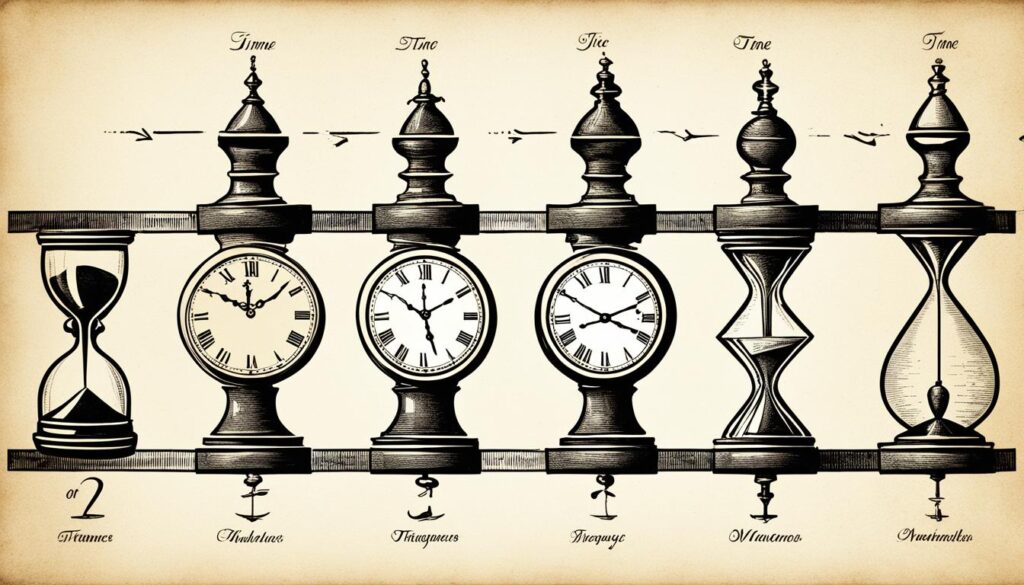Effective time management is key to reaching your goals in work and life. A study by Development Academy found only 1 in 5 people manage their time well. This article will share 15 effective techniques to boost your productivity and reduce stress.
These strategies include prioritizing tasks, avoiding multitasking, and using digital tools. They help you use your time well and achieve great results. These methods work for everyone, from busy executives to students, helping you succeed in today’s digital world.
Using these techniques will improve your productivity and balance your work and personal life. Mastering time management lets you handle important tasks better, reduce distractions, and find success in your career and beyond.
The Importance of Effective Time Management
Managing your time well is key to doing great at work and feeling good in life. Learning how to manage your time can make you more productive, help you grow in your career, and keep your work and personal life balanced. It also makes you feel better overall.
Enhancing Professional Productivity and Career Growth
Good time management helps you focus on what’s important, meet deadlines, and do quality work. A study by Think Money found that many employees get distracted for up to three hours a day. This shows how important it is to manage your time well to stay on track and grow in your career.
Balancing Work and Personal Life
Managing your time well is also key to keeping a good balance between work and life. By planning your tasks and setting clear boundaries, you can live the way you want. This balance can make you happier, reduce stress, and give you more time for family and hobbies.
“Incorporating effective time management skills is not just beneficial but also a fundamental necessity for success in academic and personal endeavors for students.”
In today’s fast world, learning to manage your time is essential for success. By using your time wisely, you can be more productive, reach your career goals, and enjoy a better work-life balance. This leads to a happier and more fulfilling life.

Understanding the Fundamentals of Time Management
Time management has changed a lot over the years. It reflects changes in work, technology, and what society values. From ancient sundials to the Industrial Revolution’s time studies, how we manage time has always changed. Knowing this history helps us understand modern time management better.
Historical Evolution of Time Management Practices
Time management has a long history. It has seen many techniques and methods over the years. In old times, sundials and other devices helped people organize their days. The Industrial Revolution brought more structured ways to manage time, like time and motion studies, to make work more efficient.
As technology got better, so did time management tools and methods. Digital calendars, task apps, and productivity software changed how we plan and do our tasks. These tools have greatly changed how we use time management principles.
The Misconception of Time Optimization
Many think that always trying to optimize time and be efficient is the way to be productive. But research shows this can harm our well-being. Thinking we can make up for lost time or that multitasking always works can increase stress and burnout.
It’s key to find a balance. This means valuing rest, social connections, and not just getting tasks done. Recognizing the need for rest and meaningful interactions can improve our productivity and happiness.

“The true measure of success is not how much time you spend, but how much you accomplish.”
Good time management isn’t just about using every minute well. It’s about finding a balance between work, rest, and personal well-being. By understanding history and the myths about time optimization, we can manage our time better for long-term success.
Time Management Techniques for Boosting Productivity
Effective time management is key to reaching your goals. By using the right strategies, you can make your work flow better, cut down on distractions, and focus on what’s most important. Planning your day ahead and using the “Eat That Frog” method are two great ways to boost your productivity.
Plan Your Day in Advance
Planning is a top strategy for managing time well. Making a daily, weekly, or monthly schedule helps you organize your tasks and see what needs to be done. You can use digital calendars, to-do lists, or paper planners to stay on track. Remember, only 2.5% of people can multitask well, so focusing on one task at a time can really help you get more done.
The Eat That Frog Approach
The “Eat That Frog” method, created by Brian Tracy, suggests starting with the biggest, toughest, and most important task first. This approach helps you beat procrastination and make sure important tasks get done, even when there are distractions. Leaders say that managing your time well and knowing what to prioritize is crucial in today’s work world.
Adding these time management tips to your daily life can make you more productive, balance your work and personal life better, and help you succeed in your career.
| Time Management Technique | Benefits |
|---|---|
| Planning Your Day in Advance | Improved organization, prioritization, and focus on critical tasks |
| The Eat That Frog Approach | Overcoming procrastination and ensuring completion of high-impact work |
“The key is in not spending time, but in investing it.” – Stephen R. Covey
Time Management Tools and Apps
In today’s digital world, many tools and apps help us manage our time better and be more productive. From digital calendars and planners to advanced task management apps, these tools have lots of features. They change how we organize our work and personal life.
Digital Calendars and Planners
Digital calendars and planners like Google Calendar and Microsoft Outlook have changed time management. They let users easily schedule meetings, set reminders, and plan their days and months. These tools help users keep track of their tasks and see their daily activities clearly. This makes them more organized and productive.
Task Management Apps
Apps like Trello, Asana, and Todoist help with organizing tasks, setting deadlines, and tracking progress. They are great for team projects. They keep team members in sync and help complete tasks on time. This makes everyone more productive.
These task management apps offer real-time tracking and advanced reporting. They give users a strong platform to manage their work. This helps in prioritizing tasks, reducing distractions, and boosting productivity.
“Effective time management is the key to unlocking your true potential and achieving your goals.”
If you’re an individual or a team working on big projects, today’s digital tools can help a lot. They make managing your time easier and can help you succeed more.
Mastering Focus and Prioritization
In today’s fast-paced world, keeping your focus and prioritizing tasks is key to boosting productivity and success. Checking and answering emails too much can be a big time trap. Workers spend about 30 hours a week on email, which could be spent on more important tasks. By only checking email at certain times, you can focus better and be more productive.
The Eisenhower Matrix is a great tool for focusing and prioritizing. It helps you sort tasks by how urgent and important they are. This lets you focus on what’s most critical first. You can divide your tasks into four areas:
- Tasks that are both urgent and important
- Tasks that are important but not urgent
- Tasks that are urgent but not important
- Tasks that are neither urgent nor important
This way, you can decide how to use your time and resources better.
| Quadrant | Description | Action |
|---|---|---|
| Urgent and Important | Tasks that require immediate attention and are critical to your goals | Do these tasks first |
| Important but Not Urgent | Tasks that are important but do not have a pressing deadline | Schedule these tasks for later |
| Urgent but Not Important | Tasks that require prompt action but are not directly relevant to your goals | Delegate these tasks or eliminate them |
| Not Urgent and Not Important | Tasks that do not contribute to your goals and can be safely eliminated | Delete or avoid these tasks |
Mastering focus and prioritization helps you work more efficiently, avoid distractions, and boost productivity and time management. This leads to better focus, prioritization, and a better balance between work and life.
Time Management in the Digital Age
In today’s fast-paced world, managing your time well is key. It helps you be more productive, balance work and life, and stay well. Using digital tools and automation can make daily tasks easier. This lets you spend more time on important and creative tasks.
Leveraging Technology for Time Management
There are many digital tools to help you manage your time better. AI-powered virtual assistants and task management apps are just the start. Automation tools like Zapier can connect different digital platforms for you, saving time. Software for managing projects, like Trello and Asana, helps with teamwork, setting priorities, and keeping track of progress.
Apps for tracking time give you insights into how you spend your days. They help you spot activities that distract you. Tools like the Pomodoro technique and Forest app make focusing easier by turning work into a game. This helps you keep a good balance between work and personal life.
Balancing Productivity and Well-being
Even with the help of digital tools, it’s important to keep a balance between work and rest. Research shows multitasking isn’t as efficient as focusing on one task at a time. Mindfulness practices, like meditation, can also help you concentrate better and make decisions more clearly.
It’s key to take regular breaks and practice healthy habits to keep your focus sharp. Digital detoxes can also help prevent burnout. By using technology wisely and focusing on your well-being, you can manage your time well in the digital age.
| Productivity Technique | Description | Benefits |
|---|---|---|
| Pomodoro Technique | Breaks work into 25-minute intervals separated by short breaks | Enhances focus, prevents burnout, and improves time management |
| S.M.A.R.T. Goal Setting | Specific, Measurable, Achievable, Relevant, and Time-based goal setting | Provides clarity, motivation, and a framework for achieving objectives |
| Kanban Method | Visual system for managing workflow and continuous improvement | Enhances productivity, collaboration, and task visibility |
“Attention is the rarest and purest form of generosity.” – Simone Weil
Conclusion
Effective time management is key in today’s fast world. It affects both work success and personal happiness. By learning about time management history, using proven methods, and digital tools, you can do more, balance work and life better, and reach your goals. The main idea is to find a method that fits you, focusing on doing well and feeling good.
This article has shown how powerful good time management can be. It covers setting priorities, avoiding distractions, and using apps to help you. These tips can help you manage your days better and succeed more.
Mastering time management is a journey of self-reflection, trying new things, and adjusting. Keep an open mind, try new methods, and get advice from experts. This will help you reach your goals and feel fulfilled.
FAQ
What is time management?
Time management is about planning how to use your time well. It helps you do more in less time. By managing time well, you can improve your work, reduce stress, and have more time for fun projects.
Why is effective time management important?
It’s key for doing well at work and feeling good in life. Good time management makes you more productive and helps you meet deadlines. It also lets you balance work and personal life, making you happier overall.
How has the concept of time management evolved over time?
Time management has changed a lot over the years. It used to be about using sundials, then time and motion studies came along. Now, we use technology to manage our time better, fitting it to our modern lives.
Is obsessive time optimization always beneficial?
Not always. The idea that being super efficient is always good is not true. Trying too hard to optimize can make you stressed and tired. It’s better to focus on what’s really important.
What are some effective time management techniques?
Good techniques include planning your day ahead, using tools like calendars and apps, and focusing on important tasks. Limiting email and using the Eisenhower Matrix can also help.
How can technology help with time management?
Technology is a big help in managing time today. Tools like AI assistants and productivity apps make routine tasks easier. They help you stay focused on what’s important.
Is there a balance between productivity and well-being?
Yes, there must be a balance. Focusing too much on being efficient can make you stressed and burn out. It’s important to take breaks and practice self-care to stay well.

